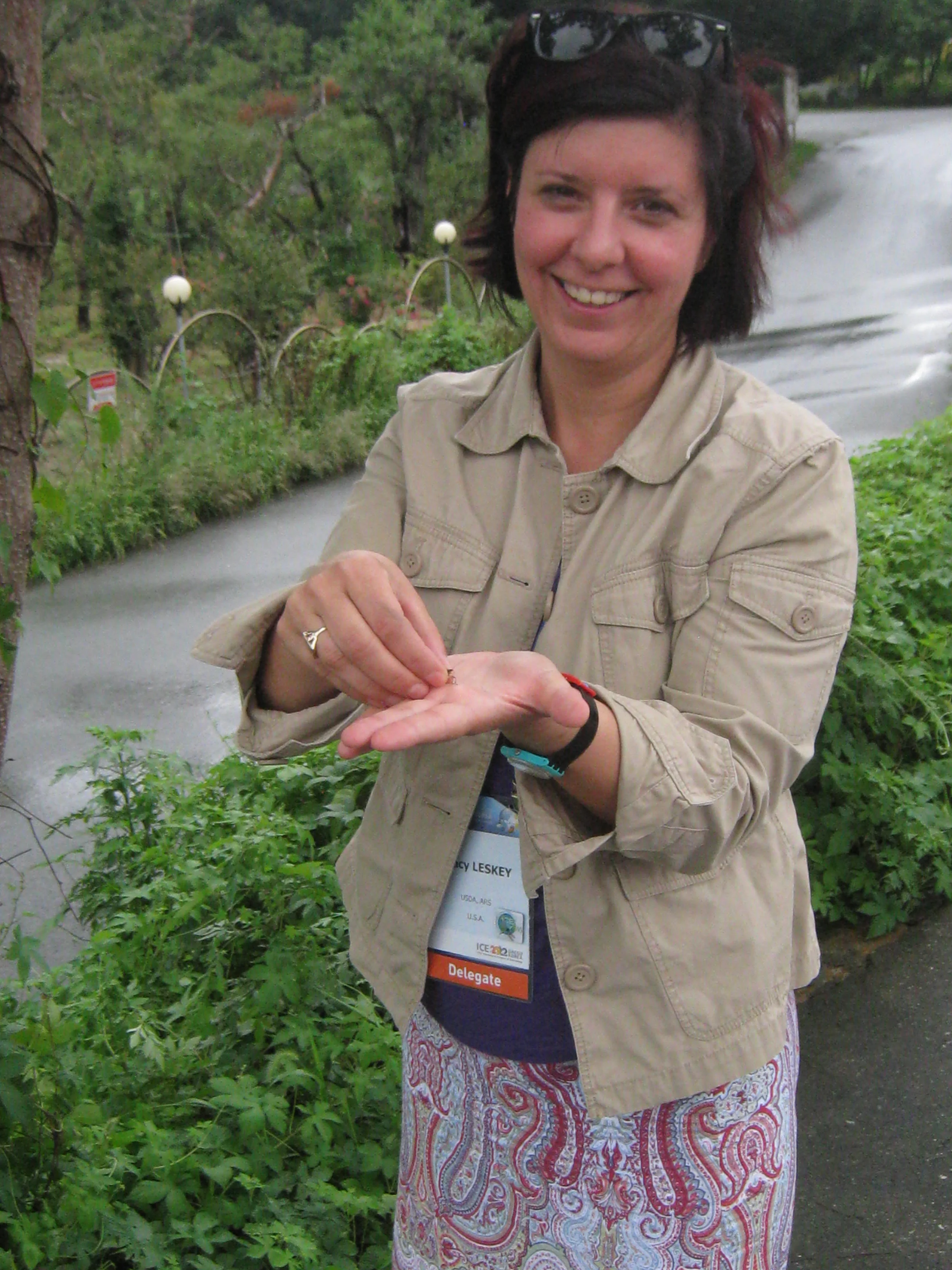Tracy Leskey... find out more about
Tracy talked in depth about some of the research she's done over the years. We couldn't include it all in her interview, but we wanted to share it here. If you're interested in what research on insect populations involves, read on!
Tracy's research as an undergraduate on the digestive systems of crane flies
We had a young professor, who was a trained entomologist. After meeting him I ended, up for my senior thesis, working on a species of crane fly. Crane flies basically look like huge mosquitoes. They’re not mosquitoes. They don’t suck blood, but they’re actually detritivores. They feed on dead leaf matter.
I ended up working with crane flies and collecting crane flies from different locations, outdoors, and then looking at a structure in them using an electron microscope to look at, what is referred to, their Malpighian tubules. Malpighian tubules are basically like the kidneys of insects, and so for an insect that lives a short period of time, it costs a lot, ecologically, to expel waste. Sometimes, rather than expelling waste, insects will just sequester them. We were looking to see if these crane flies, which, like most insects, are pretty short-lived, have these concretions sequestered in their Malpighian tubules. I got to go through the whole process of collecting the specimen, fixing them, creating the slides using the transmission electron microscope and sort of seeing that through my senior year. I realized, at that point that I was becoming more and more interested in entomology and less interested in becoming a physician.
Insect populations can destroy a food source. Tracy works to understand how to disrupt the insects and prevent them from causing so much damage.
Tracy's research as a graduate student- and its practical applications for agriculture
I went to UMass Amherst and worked with an insect known as the plum curculio, a small weevil that is a native insect. Its native host plants are wild plum species, but when the Europeans introduced apples into North America, plum curculio found that this was also a good food source. Early in the spring the adults move into commercial orchards, any apple tree really, and what they do is the female lays an egg in a fruit, but how she does it is with her mouth parts. Weevils have their mouth parts, their chewing mouth parts, but if you imagine an elephant, it’s a similar kind of thing. Actually, rather than the trunk just being able to lift things up, it could actually chew. What she will do is chew this little crescent shaped slit that looks like a half moon, and then she inserts the egg beneath it. The reason she does that is so that the rapidly growing fruit doesn’t crush the egg. What it means for an apple grower, is that it puts a worm in the fruit. It then feeds in the apple, either causing it to rot from the tree, so they lose the fruit, or it’s highly deformed. In American’s standards, consumers really demand perfection, in terms of produce, and so it’s less sellable.
I was trying to understand the visual and all olfactory cues this weevil was using to locate apple trees. How, among all of the trees in the landscape, does it find an apple orchard, and ultimately, to use that information to develop a sustainable tactic for managing them, known as behaviorally based management, where we basically disrupt their behavior by perhaps leading them in a different direction using an attractant, and perhaps trapping them out or using what we refer to as a track and kill. The reason we want to do that is we don’t want for a grower to have to treat their entire orchard with an insecticide. We’d like to reduce that as much as possible to allow them to maintain as many beneficial insects as they can and reduce the problems often associated with what we refer to as broad spectrum and insecticides that kill everything. It was really definitely taking some basic behavioral questions that we were addressing and applying them to management in commercial orchards.
Reducing insect populations by disrupting mating habits (and not by using pesticides)
We had a program, with my colleague, at Virginia Tech where we developed what is referred to as mating disruption for a species called the dogwood borer, which is a native pest, a native insect, but it is a pest in apples. They can kill the trees.
We were able to identify the sex pheromone of this insect that the females produce to attract males. If you use large amounts of that sex pheromone, and distribute it throughout an orchard, the male moth then cannot track the female because the entire orchard is permeated. It’s like if one person was wearing a perfume but you permeated the entire room with that odor, you couldn’t locate that single person who was wearing that perfume. The poor male moths can’t find the females, they don’t mate, and then that reduces the need for any insecticide against these moths.
One element of her research into stink bugs
In my laboratory we did a project. One of my postdocs was looking at the flight capacity of brown marmorated stink bug, and the way he measured that was to use what are referred to as flight mills. If you can imagine a treadmill for insects that actually attaches to the thorax, their back, and they fly in a circle, and each circle is measured through digital data acquisition software. We could look at how far they had the capacity to fly, which is easily a mile or two a day.
Then the next question is, “Okay, we know that they have that dispersal capacity, but what do they actually do in nature?” In this case, we’ve been using a technology known as harmonic radar where we tag insects with these little copper wire tags, they have a small diode, and we use a system that involves marine radar to look at their location and follow them through the environment. Getting at, “What do they actually do? Where do they actually go?” If we find out, “Oh, they’re spending more time at the border, for example, of orchards, is there a mechanism that we can use to manage them there rather than having them invade the orchard and affect the crops?” Each question leads to an answer, but each answer leads to a new question. It’s always evolving and it’s never done.
It’s worked really well. Brown marmorated stink bug is a large enough bug that it can tolerate the weight of a tag because that is always the question, if the insect can tolerate and carry that weight. I’ve tried it with other insects and some have been too small, but for a marmorated, it doesn’t affect their behavior. So we could use it to ask biological and ecological questions. We had, at some point, some press here to cover the stink bug story, and they thought it looked a little bit sci-fi but it works really well.
Read our interview with Tracy and check out her reading picks!
Tracy Leskey is an entomologist: a scientist who studies bugs. She's loved insects since she was a little girl with a Golden Book on monarch butterflies. Tracy combined her love of nature with a love of biology, and today is a researcher for the US Department of Agriculture. She works to protect food growers from invasive insects like the brown marmorated stink bug by finding sustainable, ecologically sound solutions.


